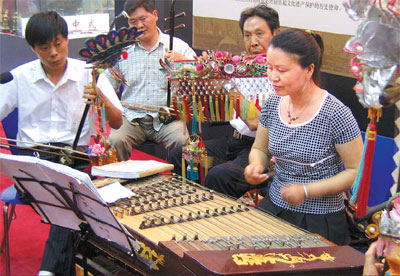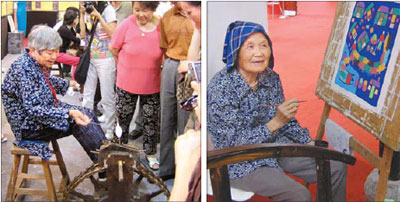| Tools: Save | Print | E-mail | Most Read |
| Shanghai's Hidden Treasures |
| Adjust font size: |
It is a mighty metropolis bustling with energy and excitement. It showcases China's cutting-edge modern living and its people are famous for being focused on all that is new. However beneath the glitz and glamor of life in the fast lane lies a little-known side of traditional Shanghai. On this side, you can hear the sound of silk and bamboo music, savor the unique taste of traditional snacks, and watch cloth makers spin their wheels. You can also see artist farmers capture their experiences on canvas. Last week's Shanghai Folk Culture Exposition showed off local treasures that are often overshadowed by modern development.
Expo visitors were greeted by the sounds of Jiangnan Sizhu, or the silk and bamboo music, which was voted as one of China's intangible cultural heritage items. Jiangnan refers to the south bank of the lower Yangtze River basin near Shanghai where this style of ensemble music is popular. "Silk" relates to string instruments and "bamboo" to woodwind. The Shanghai Intangible Cultural Heritage Preservation Center invited different silk and bamboo bands to perform at the expo to the delight of visitors. "The silk and bamboo music of Jiangnan is like a name card of Shanghai," says Zhou Feng, a musician from the Gucheng Silk and Bamboo Band. "Wherever in the world you hear it, you know it is music from Shanghai. It tells much about the life of Shanghai's people." The members of Gucheng band all have other jobs, but gather every Tuesday afternoon to rehearse. "In the silk and bamboo music of Jiangnan, professional musicians are amateurs, while amateur musicians are professionals," says Zhou. Professional musicians trained at conservatories do not always master the spirit of silk and bamboo music and often the best musicians are local people without formal training. "It's a very exquisite music style that demands high personal accomplishment, but when you get into it, you will become addicted," says Zhou. Despite the large numbers of silk and bamboo bands in Shanghai, Zhou is very worried about the future. "Most players of the silk and bamboo music of Jiangnan are quite elderly," says 57-year-old Zhou, who is one of the youngest in his group. "Not many people realize this precious music is being lost." Gong Jinguo, a musician of the Zhuqiao Silk and Bamboo Band from the Nanhui District of Shanghai, says the silk and bamboo music of Jiangnan's listing on the national intangible cultural heritage register will help promote and preserve the music. He says his band is active in the city's outskirts performing at weddings, temple fairs, and folk festivals. "At the folk culture exposition we learned much about other folk arts, at the same time we have a very good opportunity to promote the silk and bamboo music of Jiangnan," says Gong. Another of Shanghai's intangible cultural heritage treasures at the expo were paintings from Jinshan farmers. Jinshan District is located southwest of Shanghai, and since the 1970s, local farmers developed a kind of art form, which combines elements from traditional arts, such as paper-cuts, embroidery and knitting. Drawing from their life experiences and romantic imaginations, the people of the land have created many paintings full of freshness and images of the Shanghai countryside. The works of Jinshan farmers have been exhibited around the world in more than 20 countries, and more than 200 pieces have been collected by the National Art Museum of China, the Research Institute of Chinese Paintings and the China Folk Arts Museum. "All my paintings come from my own head," says 77-year-old Xu Guibao, who was drawing a picture of the folk lion dance at the expo. "I paint every day, and I have been doing it for 30 years." According to Zhu Xi, deputy director of the Jinshan Farmers' Painting Academy, farmers' works are sold mainly through art galleries and snapped up by tourist groups visiting Jinshan. The prices of the works range from 40 yuan ($5.7) to 500 yuan ($65). The academy has also developed other forms of merchandise, based on the farmers' paintings, such as cups, drink coasters, greeting cards, stamps, and T-shirts. All sold well at the exposition. "This exhibition reminded me of my childhood in Jinshan. All the subjects in the paintings are so familiar to me," says 63-year-old Lin Hongqing, a visitor to the show. However he says the times have changed. When Lin was a boy, a boat trip from Shanghai to Jinshan took five hours. Today, the journey is only a 30-minute drive down the highway. "Life in Jinshan is almost as modern as it is in Shanghai now, and much of the folk culture is disappearing," he says. "At the Shanghai Folk Culture Exposition we can see the variety of folk culture that needs our care." The expo not only showed off Shanghai folk culture, it also introduced arts and crafts from other areas, including Taiwan. Taiwan's craftswoman Chen Li Yu Mei showed off her traditional embroidery and jewelry making, while paper artist Hung Hsin-Fu demonstrated how to create works using ordinary paper. Under Hung's direction, many visitors created simple yet beautiful paper faces with only two cuts from a pair of scissors.
"Paper art is a kind of educational medium, which enables people to develop their thinking and imagination," says Hung, who has published 14 books on the subject. "Paper is something cheap and easy to get, but one can develop endless possibilities from it." Hung was only 4 years old when he first encountered paper crafts. At age 11 the hobby became a passion and by 17 he decided to make it his life-long profession. Hung says he used to be very careless when he was a child, but after practicing paper art he became more patient and logical. He says his beloved paper art also helped improve his mathematical powers. Hung's works include realistic images, such as animals and sports and also abstract titles such as Dream, Buddha and Proliferation. "I develop my paper art works from the traditional Chinese crafts, but with my own original ideas," he says. "As the time changes, mass products have largely replaced handicrafts, but handicrafts will always have their uniqueness." In his works, Hung seldom uses glue, but borrows the idea of tenon from Chinese carpentry. However, he also tries to make use of modern techniques, such as lasers. This year was the first time Hung had participated in the Shanghai Folk Culture Exposition, and he found it very rewarding. "I exchanged ideas and experiences with many colleagues from the mainland," he says. "Wherever there is mutual understanding, there is no conflict." Hung also found a new business partner. He has signed a contract with Shanghai Jiansheng Culture and Education Development Company, who is presenter of the exposition, to promote his paper art works on the Chinese mainland. (China Daily June 20, 2007) |
| Tools: Save | Print | E-mail | Most Read |
 |
| Related Stories |
|

